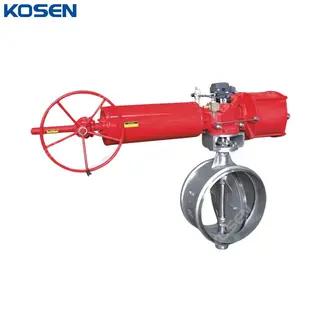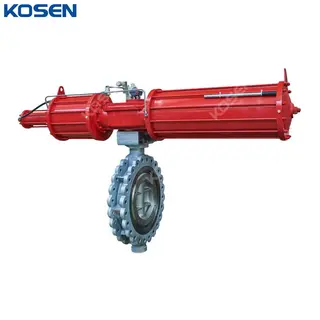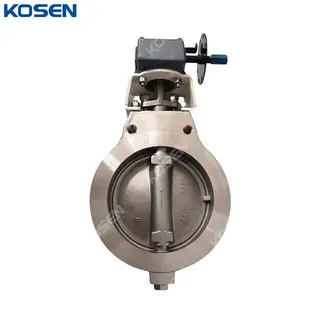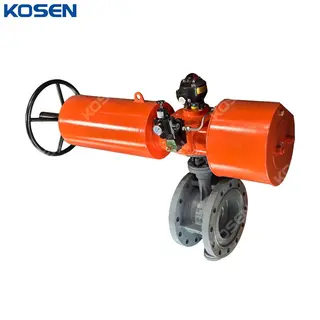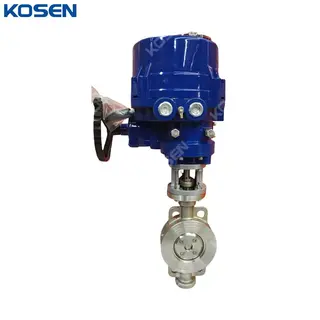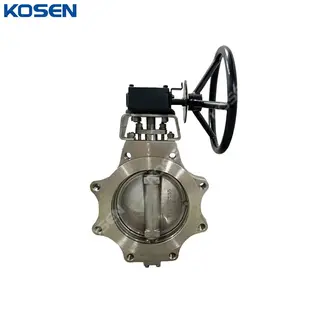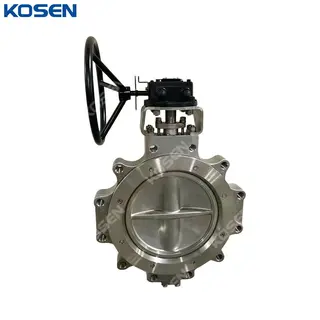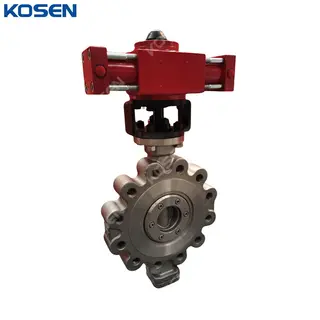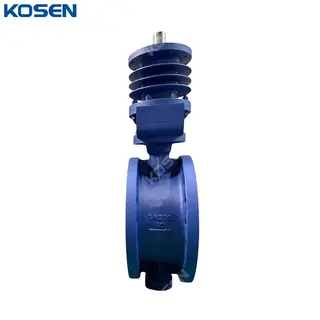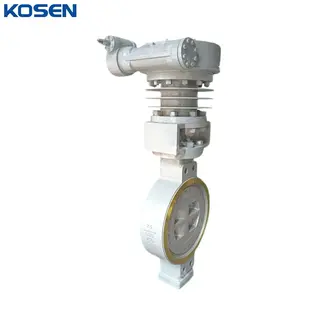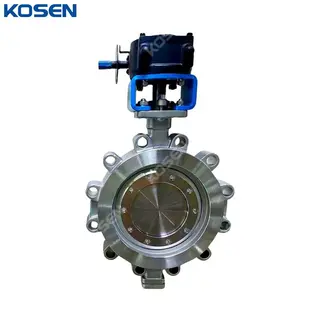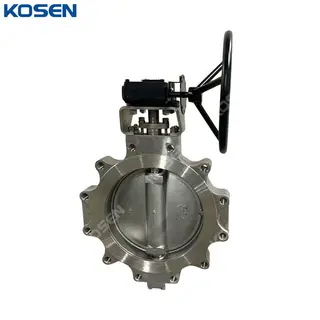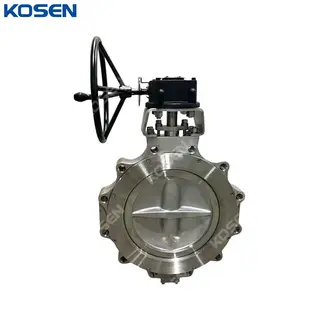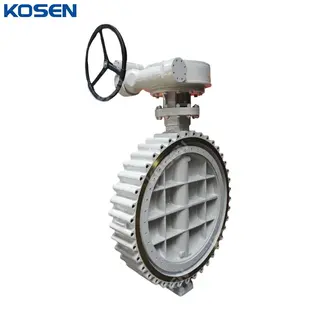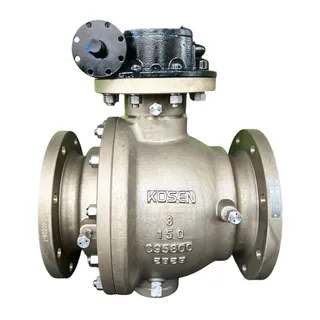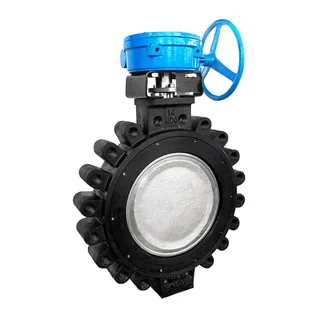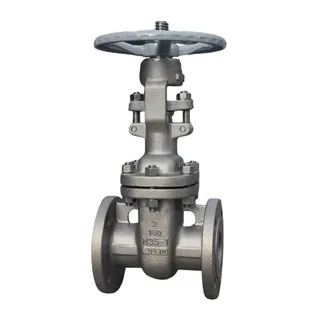The working principle of butterfly valves is simple and straightforward. It primarily controls the flow and direction of fluid through the rotation of the valve disc. When the disc is in the closed position, it forms a sealed space between the disc and the seat, preventing fluid leakage. When the disc rotates to the open position, the gap between the disc and the seat gradually increases, allowing fluid to flow through the valve. Butterfly valves function by rotating the valve disc, which typically rotates 90 degrees to regulate the flow. When the disc reaches 90 degrees, the valve is fully open, allowing smooth fluid flow. Flow control is achieved by adjusting the angle of the valve disc, and butterfly valves are generally installed along the pipe's diameter direction.
It is important to note that butterfly valves and valve stems do not have an automatic locking function. To improve flow control, they are often equipped with a worm gear reducer. Butterfly valves with a worm gear reducer not only allow automatic locking but also enhance the valve's performance, providing more precise flow regulation.
Butterfly valves are categorized based on the position of the valve shaft, and they include concentric butterfly valves, single-offset butterfly valves, double-offset butterfly valves, and triple-offset butterfly valves. By adjusting the position of the shaft, these types influence sealing and opening/closing states, making them suitable for different working environments.
Concentric butterfly valves feature a design where the valve shaft, disc center, and valve body center are aligned. Due to this design, the disc and seat remain in continuous compression and scraping during opening and closing, resulting in higher opening resistance and faster wear. Consequently, concentric butterfly valves have poorer sealing performance, making them suitable for medium- and low-pressure and medium- to low-temperature media conditions, particularly in lug-style butterfly valves. Their simple structure allows for easy installation and maintenance but is limited by sealing performance, often used in less demanding applications.
The single-offset butterfly valve improves upon the concentric design. In this type, the valve shaft is offset from the disc center, reducing the excessive compression between the upper and lower ends of the disc and the seat. This design significantly reduces friction and wear, extending the seat's lifespan and improving opening/closing resistance. The single-offset butterfly valve is particularly well-suited for applications where reduced wear and increased service life are critical.
The double-offset butterfly valve is a further improvement over the single-offset design and is the most commonly used type. The key feature of the double-offset design is that the valve shaft is offset both from the disc center and the valve body center. This design ensures that the disc quickly disengages from the seat during opening, eliminating unnecessary compression and scraping, which significantly reduces opening resistance, minimizes wear, and enhances the seat's lifespan. Double-offset butterfly valves are widely used in applications requiring high sealing performance and long service life.
The triple-offset butterfly valve is the most advanced type and overcomes some of the limitations of the double-offset design. Unlike the double-offset valve, the triple-offset valve employs a conical sealing design, rather than the traditional frusto-conical seal. This design allows it to use hard seals at high temperatures and significantly reduces leakage. The valve shaft in the triple-offset butterfly valve features a three-segment axis structure, with the center axis offset from the two end axes. This structure ensures that the disc remains in a double-offset position when fully open and a single-offset position when closed, ensuring the sealing surfaces align and achieving a reliable sealing effect. Triple-offset butterfly valves are typically used in high-temperature, high-pressure, and high-sealing-demand applications.
The design and construction of butterfly valves consist of several key components: the valve body, seat, shaft, and disc. These components work together to achieve fluid control functionality.
1. Valve Body
The valve body is the main component of the butterfly valve and is typically made of materials such as cast iron, carbon steel, or stainless steel. Its primary function is to bear the pressure and load from the pipeline and provide a stable base for the installation of other components. The structural design of the valve body ensures stability and safety during operation.
The valve seat is typically made of materials such as rubber or PTFE (polytetrafluoroethylene) and serves a sealing function to prevent fluid leakage between the valve body and disc. This sealing material effectively reduces leakage rates and improves the valve's sealing performance.
The valve shaft connects the disc to the driving mechanism and is typically made of stainless steel or other corrosion-resistant materials. The shaft's role is to transmit the driving force to the disc, enabling the rotation that controls the fluid flow.
The valve disc is the core component of the butterfly valve, typically made from stainless steel or aluminum alloys, with a surface coating of sealing materials like rubber or PTFE. The disc is connected to the shaft and driven by the actuator to rotate and regulate the fluid flow, ensuring smooth and reliable control of the fluid.
Due to their unique design and performance, butterfly valves are widely used in various industries, particularly in fields where precise fluid control is required. Here are some key industry applications for butterfly valves.
In the chemical industry, butterfly valves play a crucial role. Given the strict requirements for controlling fluid flow and direction in chemical production processes, butterfly valves are ideal due to their precise flow regulation and excellent sealing performance. They are widely used in controlling the flow of chemicals, ensuring smooth production processes and minimizing risks from fluid leaks or uneven flow.
In the oil and gas industry, butterfly valves are essential. Oil and gas pipelines often operate in extreme environments with high temperatures and pressures, and butterfly valves can handle these conditions, effectively regulating the flow of oil and gas while ensuring pipeline safety. Their reliable performance makes them key components in fluid control systems within this industry.
In the water treatment industry, butterfly valves are commonly used in both potable water supply and wastewater treatment systems. Their low flow resistance and flexible operation make them ideal for water flow control. Whether in water transportation, distribution, or wastewater treatment, butterfly valves ensure precise flow regulation and efficient system operation.
In the food and pharmaceutical industries, the material and hygiene standards for valves are particularly strict. Butterfly valves are widely used in these sectors because of their non-toxic, odorless, corrosion-resistant, and easy-to-clean properties. They help maintain high hygiene and safety standards during food and pharmaceutical production, ensuring compliance with industry quality control requirements.
When selecting a butterfly valve, it is essential to consider the system's specific needs and working conditions. Here are some key considerations.
Butterfly valves typically have higher pressure losses, about three times that of gate valves. Therefore, it is important to consider the pressure loss tolerance of the piping system. Butterfly valves are more suitable for systems where pressure loss is not a critical factor.
Butterfly valves are especially suited for large-diameter valve designs, particularly when short structural lengths and fast opening/closing speeds are required. Choosing the correct size and type ensures efficient operation in flow control applications.
In high-temperature conditions, the material of the elastic seat has limited temperature resistance. When selecting a butterfly valve, ensure the seat material can withstand the operating temperature range, especially in high-temperature environments.
Flow Regulation and Throttling: Butterfly valves are ideal for flow regulation and throttling, especially in slurry media or applications requiring quick opening and closing (e.g., quarter-turn valves).
Low-Pressure Systems and Cavitation: Butterfly valves are suitable for low-pressure shutoff, two-position regulation, and systems experiencing cavitation or vaporization.
Special Sealing Requirements: For applications requiring strict sealing or handling high wear, low temperatures, or other extreme conditions, a triple-offset or double-offset metal-seated butterfly valve is required.
Concentric Butterfly Valves: Suitable for applications requiring complete sealing and zero leakage, with operating temperatures between -10°C and 150°C, commonly used in water treatment, natural gas, food, pharmaceuticals, and oil pipelines.
Soft-Seated Eccentric Butterfly Valves: Used for bi-directional on/off control and regulation in ventilation and dust collection systems, widely used in metallurgy, power, and petrochemical gas pipelines.
Metal-to-Metal Seated Double-Offset Butterfly Valves: Suitable for regulation and throttling in urban heating, gas, and water systems.
Metal-to-Metal Seated Triple-Offset Butterfly Valves: Used in large gas separation units and widely applied in industries such as oil, chemical, and power for critical valve applications.
Butterfly valves are ideal for pipeline systems with less stringent pressure loss requirements.
Butterfly valves are the optimal choice for flow regulation in pipeline systems.
They are unsuitable for high-temperature and high-pressure pipeline systems, typically operating below 300°C with nominal pressure not exceeding PN40.
They are suitable for applications requiring short structural lengths, especially for large-diameter valves (DN1000 and above).
Due to their 90° rotation for opening and closing, butterfly valves are suitable for applications requiring fast actuation.
Butterfly valves are widely used across many industrial sectors due to their simple structure, rapid operation, and suitability for large diameter applications. However, despite their numerous advantages, butterfly valves do come with certain limitations. Below are the main pros and cons of butterfly valves.
Easy and Quick Operation: The butterfly valve operates with a simple 90° turn to open or close, making it energy-efficient and well-suited for frequent operations.
Low Fluid Resistance: Especially in the fully open position, the effective flow area through the valve seat is large, which significantly reduces fluid flow resistance.
Simple Structure and Compact Design: Butterfly valves are designed with a simple structure and are compact, making them lightweight and suitable for large-diameter applications where space is limited.
Handling of Mud and Low Fluid Accumulation: These valves are capable of handling slurry or particulate-laden fluids, and their design minimizes liquid accumulation at the pipe entry, making them ideal for complex media flows.
Good Regulation Performance: Butterfly valves allow for precise flow regulation, making them widely used in throttling and control systems.
Effective Sealing Performance: At low pressures, butterfly valves provide good sealing, especially soft-seated versions that offer excellent sealing capabilities.
Low Operating Torque: The unique design of the butterfly valve allows the torque on both sides of the valve plate to be equal and in opposite directions, reducing the effort needed for opening and closing.
Easy Installation: Butterfly valves are small in size and easy to install, with various mounting options to facilitate easy connection with pipelines.
Flexible Operation Methods: Butterfly valves can be manually, electrically, pneumatically, or hydraulically operated, offering flexibility to meet different automation needs.
Limited Temperature and Pressure Range: Compared to other valves like ball and gate valves, butterfly valves have relatively poor resistance to high temperatures and high pressures, typically not exceeding 300°C, with a pressure rating usually below PN40.
Lower Sealing Performance: While butterfly valves provide good sealing at low pressures, their sealing performance is not as effective as ball valves or globe valves, making them unsuitable for applications that require strict sealing.
Limited Flow Control Range: Butterfly valves have a limited flow control range. Specifically, once the valve is open beyond 30%, the flow increases rapidly to 95% or more, making them less suitable for applications requiring precise flow control.
Proper installation is crucial to ensuring the performance and longevity of butterfly valves. Below are the main requirements for their installation.
Check Specifications and Components: Before installation, verify that the valve's specifications, pressure, temperature, and corrosion resistance meet the operational requirements. Inspect all parts for any damage or looseness to ensure the valve is in good working condition.
Installation Position and Direction: Butterfly valves can be installed in any pipe orientation, though installation in the closed position is typically recommended. During welding of the pipeline flanges, the valve sealing surface should be covered to prevent debris from entering and damaging the sealing face. After welding, remove the valve and clean both the sealing surface and the inner pipeline.
Clean Sealing Surfaces: Thoroughly clean the valve sealing surfaces, including both ends, the butterfly plate, and the valve seat, to remove dirt and ensure good sealing performance.
Test the Valve: Perform an air test before installation to check the valve's opening and closing function. Ensure the valve opens and closes smoothly and that the position indicator aligns with the actual valve position. When operated manually, turning clockwise should close the valve, and counterclockwise should open it.
Bolt Tightening: Tighten the valve bolts in an alternating, symmetrical pattern to avoid uneven pressure on the sealing surface, which could affect sealing performance.
Adjust Limit Screws: Limit screws are pre-adjusted at the factory and should not be altered. If the valve is equipped with a drive unit (e.g., electric or pneumatic), refer to the drive unit's manual for correct installation and adjustment.
Electrical Testing for Electric Butterfly Valves: For electric butterfly valves, before connecting to power, manually open the valve to the half-open position, then use the point-to-point switch to ensure the direction of the indicator plate matches the valve's opening direction. If there is an issue with operation, inspect and repair the malfunctioning components.
Maintenance and Care of Butterfly Valves
Regular maintenance and care of butterfly valves can effectively extend their lifespan and ensure smooth operation. Below are the key points for maintaining and servicing butterfly valves.
1. Maintenance of Butterfly Valves
Regular Inspections: Inspect the connections and sealing regularly. If any loosening or leakage is found, address it promptly.
Cleaning Debris: Keep the valve interior clean to ensure smooth operation of the valve.
Inspect Seals: Check the sealing rings and surfaces for wear, and replace them as necessary.
Long-Term Storage: Before placing a butterfly valve in long-term storage, conduct a test run to ensure it operates properly.
Lubrication: Apply specialized lubricants to the valve to ensure smooth operation.
Check Bolts: Periodically check and tighten bolts to prevent loosening.
Avoid Overuse: Avoid frequent opening and closing to prevent damage to sealing surfaces.
Paint Treatment: Regularly apply protective coatings to prevent corrosion and oxidation.
Disassembly: When disassembling the valve, remember the installation sequence to facilitate reassembly.
Cleaning: Use clean tools to wash the valve, avoiding any damage to the sealing surfaces.
Check Seals: Inspect sealing surfaces and rings, replacing them if necessary.
Reassembly: Ensure seals are properly installed to maintain sealing performance.
Some common issues with butterfly valves primarily concern sealing performance and operational issues. Sealing issues often manifest as internal or external leaks, while operational issues may include foreign object blockage, wear of moving parts, or actuator failure. These issues can all impact the valve's ability to open and close properly and control flow.
Internal Leaks: Over time, friction between the butterfly plate and valve seat can lead to wear, causing internal leaks. Minor wear can often be fixed through grinding, but severe wear may require replacing the sealing surface or the entire valve.
External Leaks: External leakage can be caused by a failure of the gasket, uneven tightening of flanges, or damage to the valve stem seal. Replace the gasket and tighten the flange bolts evenly. Inspect the valve stem seal and repair or replace any damaged components.
Foreign Object Blockage: Check for foreign objects trapped between the butterfly plate and valve seat or within the actuator. Clean out any debris. For sticky or scaling media, clean the valve periodically.
Worn or Damaged Components: Moving parts like the worm gear, gears, or linkages can wear out, causing the valve to malfunction. Inspect these parts for damage and replace or repair as needed. Ensure proper lubrication for smooth operation.
Actuator Issues: In electric, pneumatic, or hydraulic butterfly valves, actuator failures (e.g., motor failure, insufficient air pressure, or hydraulic cylinder leakage) may cause abnormal valve movements. Inspect and repair faulty components. Check the valve stem for any bending or sticking and replace if necessary.
Lubrication Problems: Lack of lubrication on moving parts and bearings can increase friction and cause sluggish valve operation. Ensure regular lubrication.
Power Supply Issues: In electric butterfly valves, low voltage or poor contact in the electrical circuit can affect valve operation. In pneumatic systems, insufficient or unstable air pressure can cause slow response times. Verify the power or air supply is functioning correctly.
In conclusion, butterfly valves provide a highly effective solution for controlling fluid flow in a range of industrial settings. Their simple yet robust design, combined with various types suited for specific applications, ensures that they meet diverse operational requirements. Whether in low-pressure or high-demand environments, the versatility of butterfly valves allows for optimized flow regulation, easy installation, and minimal maintenance. Despite some limitations, their benefits make them a go-to choice for many fluid handling systems, offering a balance of performance, cost-effectiveness, and reliability. Proper selection, installation, and maintenance are key to maximizing their effectiveness and longevity.
